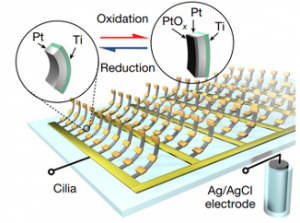Difference between revisions of "Simulation of 2D artificial cilia metasurface in COMSOL"
From iis-projects
| Line 1: | Line 1: | ||
[[File:COMSOL_Simulation.png|thumb]] | [[File:COMSOL_Simulation.png|thumb]] | ||
| − | |||
| − | |||
| − | |||
| − | |||
| − | |||
| − | |||
| − | |||
| − | |||
| − | |||
==Project Description== | ==Project Description== | ||
Cilia are microscopic hair-like organisms everywhere in the biological world, and they are effective in both sensing and actuation. Researchers are now borrowing ideas from the biological cilia to build artificial cilia that can be useful in many applications such as microfluidic pumping, mixing, and chemical sensing. Our group is exploring to post-process such artificial cilia in an array fashion to CMOS chip using multiple actuation methods including magnetic, electrostatic, and electrochemical effects[1,2,3], thus they can be better controlled for many applications. To better understand how the cilia array will affect fluid dynamics, we have implemented a 1D cilia array COMSOL simulation of the solid-fluidic interaction model. Now we hope to extend this model to 2D metasurface such that it becomes more practical. Your main task will be studying and improving the existing model and extending the model to 2D metasurface case. Through the projects, you will learn how to model multiphysics problems in COMSOL and process the data in MATLAB. You will also learn how related fabrication techniques can be transferred to CMOS platform. Contact me for more details if you are interested. | Cilia are microscopic hair-like organisms everywhere in the biological world, and they are effective in both sensing and actuation. Researchers are now borrowing ideas from the biological cilia to build artificial cilia that can be useful in many applications such as microfluidic pumping, mixing, and chemical sensing. Our group is exploring to post-process such artificial cilia in an array fashion to CMOS chip using multiple actuation methods including magnetic, electrostatic, and electrochemical effects[1,2,3], thus they can be better controlled for many applications. To better understand how the cilia array will affect fluid dynamics, we have implemented a 1D cilia array COMSOL simulation of the solid-fluidic interaction model. Now we hope to extend this model to 2D metasurface such that it becomes more practical. Your main task will be studying and improving the existing model and extending the model to 2D metasurface case. Through the projects, you will learn how to model multiphysics problems in COMSOL and process the data in MATLAB. You will also learn how related fabrication techniques can be transferred to CMOS platform. Contact me for more details if you are interested. | ||
| Line 28: | Line 19: | ||
*Wang W, Liu Q, Tanasijevic I, et al. Cilia metasurfaces for electronically programmable microfluidic manipulation[J]. Nature, 2022, 605(7911): 681-686. | *Wang W, Liu Q, Tanasijevic I, et al. Cilia metasurfaces for electronically programmable microfluidic manipulation[J]. Nature, 2022, 605(7911): 681-686. | ||
| + | ==Contact== | ||
| + | *Zhikai Huang :[mailto:zhhuang@ethz.ch zhhuang@ethz.ch] | ||
| + | *Prof. Dr. Hua Wang :[mailto:hua.wang@iis.ee.ethz.ch hua.wang@iis.ee.ethz.ch] | ||
| + | |||
| + | Last Update: 07.02.2023 | ||
[[#top|↑ top]] | [[#top|↑ top]] | ||
| − | + | ||
| + | [[Category:Available]] | ||
| + | |||
| + | [[Category:Semester Thesis]] | ||
Revision as of 10:04, 14 February 2023
Project Description
Cilia are microscopic hair-like organisms everywhere in the biological world, and they are effective in both sensing and actuation. Researchers are now borrowing ideas from the biological cilia to build artificial cilia that can be useful in many applications such as microfluidic pumping, mixing, and chemical sensing. Our group is exploring to post-process such artificial cilia in an array fashion to CMOS chip using multiple actuation methods including magnetic, electrostatic, and electrochemical effects[1,2,3], thus they can be better controlled for many applications. To better understand how the cilia array will affect fluid dynamics, we have implemented a 1D cilia array COMSOL simulation of the solid-fluidic interaction model. Now we hope to extend this model to 2D metasurface such that it becomes more practical. Your main task will be studying and improving the existing model and extending the model to 2D metasurface case. Through the projects, you will learn how to model multiphysics problems in COMSOL and process the data in MATLAB. You will also learn how related fabrication techniques can be transferred to CMOS platform. Contact me for more details if you are interested.
Requirements
- Interested in interdisciplinary research
- Previous experience with COMSOL/MATLAB is preferable
Project Components
- 20% Literature research
- 40% COMSOL modeling and simulation
- 20% MATLAB modeling and processing
- 20% Documentation
Background Material
- den Toonder J, Bos F, Broer D, et al. Artificial cilia for active micro-fluidic mixing[J]. Lab on a Chip, 2008, 8(4): 533-541.
- Khaderi S N, Den Toonder J M J, Onck P R. Microfluidic propulsion by the metachronal beating of magnetic artificial cilia: a numerical analysis[J]. Journal of fluid mechanics, 2011, 688: 44-65.
- Wang W, Liu Q, Tanasijevic I, et al. Cilia metasurfaces for electronically programmable microfluidic manipulation[J]. Nature, 2022, 605(7911): 681-686.
Contact
- Zhikai Huang :zhhuang@ethz.ch
- Prof. Dr. Hua Wang :hua.wang@iis.ee.ethz.ch
Last Update: 07.02.2023
